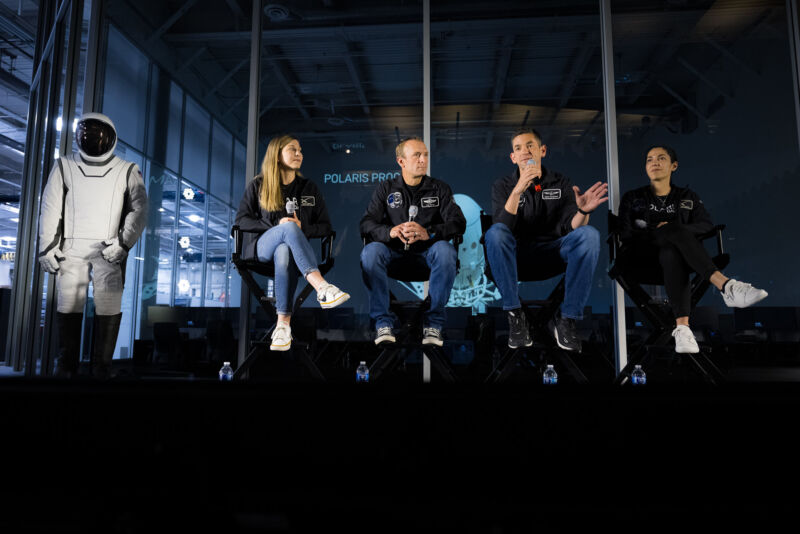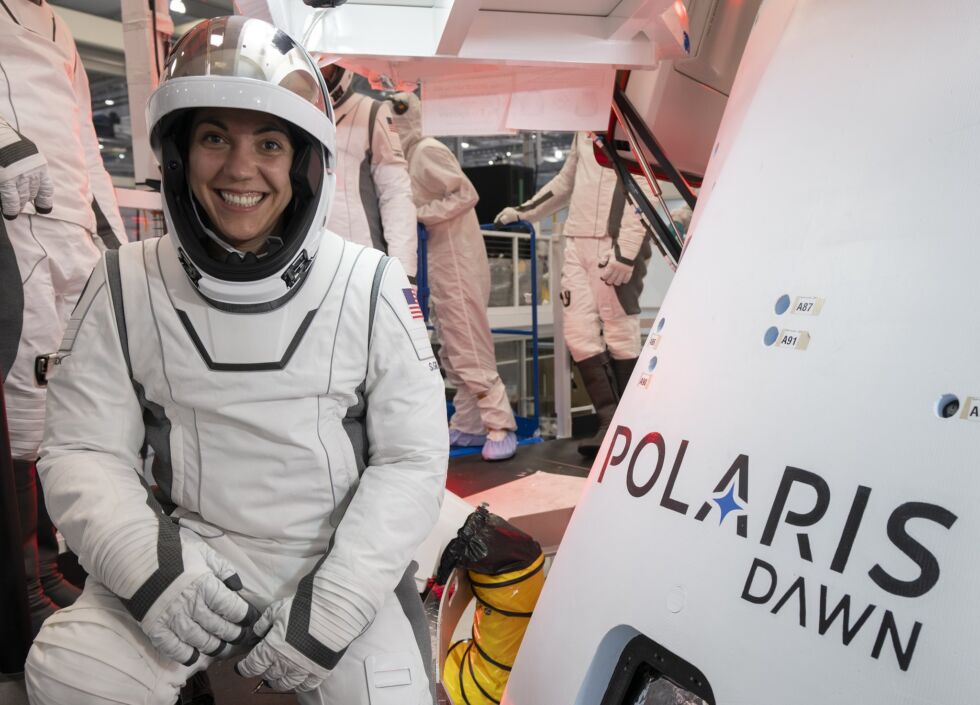A new dawn —
Polaris Dawn will be the first time that SpaceX employees have actually gone to space.

Enlarge / The crew of Polaris Dawn from L to R: Anna Menon, Scott Poteet, Jared Isaacman, and Sarah Gillis.
John Kraus/Polaris Program
Over the weekend the crew of the upcoming Polaris Dawn mission shared a wealth of details about the intriguing private mission that will send humans farther than they have flown from Earth in half a century.
Commanded and funded by private astronaut Jared Isaacman, the mission seeks to test new technologies that will further the expansion of humanity into space. Among the objectives are pushing the performance of the Dragon spacecraft and Falcon 9 rocket, performing the first commercial spacewalk in a new spacesuit developed by SpaceX, and testing Starlink laser-based communications in space.
“Our first objective is to travel farther from the Earth and the last time humans walked on the Moon with Apollo 17, more than 50 years ago,” Isaacman said during an online chat hosted by the social network site X. “So we target an apogee of 1,400 kilometers. That puts us just inside the Van Allen radiation belt. It’s an awesome opportunity for us to get some data, but really it’s about pushing beyond our comfort zone.”
The Polaris Dawn mission does not have a launch date, but SpaceX officials confirmed that it is now the next crewed mission the company will fly. There are likely several scheduling issues at play, but it’s possible the mission could launch within the next six to eight weeks.
Flying high
After liftoff from Florida, Isaacman said Dragon will complete seven orbits with a maximum altitude of about 1,400 km, which is about twice as high as any crewed mission has flown since 1972. After that the vehicle will descend to a more circular orbit of about 700 km and prepare for a spacewalk.
Besides Isaacman, who flew to space for the first time in September 2021 as the commander of the all-civilian Inspiration 4, the crew of this mission includes a retired Air Force Lieutenant Colonel and experienced pilot named Scott Poteet, and two SpaceX engineers, Sarah Gillis and Anna Menon. This will be the first time that any employee of SpaceX has ever flown into space.
After settling into the lower orbit, the crew will prepare for a spacewalk. They will don spacesuits, and the atmosphere inside the Dragon spacecraft will be vented into space. Then Isaacman and Gillis will exit the spacecraft, with their suits connected to Dragon’s air and other consumables by an umbilical.

Enlarge / Polaris Dawn astronaut and SpaceX engineer Sarah Gillis shows off the new spacesuit.
SpaceX
Although government astronauts have conducted hundreds of spacewalks over the last 60 years, no private citizen has ever undertaken one.
“This is important because we are going to get to the Moon and Mars one day, and we’re going to have to get out of our vehicles, and out of the safety of the habitat to explore and build and repair things,” Isaacman said. SpaceX has already said it is working on a second generation of the suit for operations on the Moon and Mars.
The company spent about two years designing the first generation of this extravehicular activity spacesuit, an upgrade from its current flight suit. It has been extensively tested in vacuum chambers and other facilities at locations such as NASA’s Johnson Space Center. Isaacman shared more details about the suits in a subsequent conversation with former Canadian astronaut Chris Hadfield.
SpaceX has also modified Dragon for the spacewalk. Stu Keech, the vice president of Dragon at SpaceX, said a structure named “Skywalker” has been attached to the spacecraft near the hatch as a mobility aid.
Is this guy legit?
It would be easy to dismiss Isaacman as a space fanboy living out his spaceflight dreams after he got rich. (According to Forbes, the founder of Shift4 Payments is worth an estimated $1.5 billion.) Absolutely, he loves to fly. He owns and regularly pilots a MiG-29—one of only a few of these Soviet fighter aircraft operating in the United States. Spaceflight is the ultimate boundary for people who love to fly.
But Isaacman appears to be in this for more than thrills. On his first two spaceflights, Isaacman sought out crewmates from diverse backgrounds and made charitable donations a major component of each mission. I have had a number of conversations with Isaacman over the last five years, and he has consistently emphasized the goal of opening spaceflight to more people. For example, if humans are ever to have a truly sustained presence in space, spacewalks must be commonplace. Hence, non-NASA astronauts need to start making them. His funding of Polaris Dawn helped SpaceX focus on developing suits for such a purpose down the line.
During the social media event on Saturday, I asked Isaacman about the risks entailed by this mission. By flying higher than a conventional spaceflight, venting the cabin, and performing a spacewalk, he and the crew were taking on a new set of risks.
“We’ve gotten really comfortable going from point A to B to an extraordinary floating international laboratory, but I think humankind’s ambitions are beyond that,” Isaacman said of the International Space Station. “We’re going to encounter different things. The risk is different when you vent the vehicle down to vacuum, and you’re in a spacesuit. But I think these are all positive steps in the direction of goodness towards, you know, humankind’s interest to explore our Solar System and beyond.”
Isaacman has clearly bought in to the idea of space settlement. He’s personally taking risks to help achieve that vision, investing a significant chunk of money and time for training. It is a brave and bold and important thing to be doing.